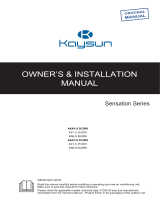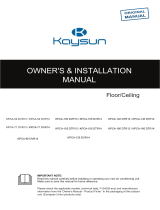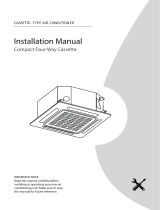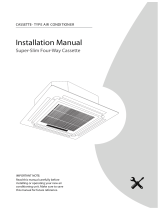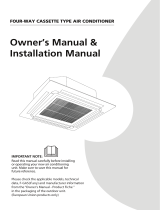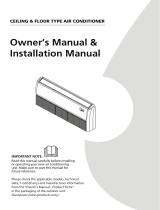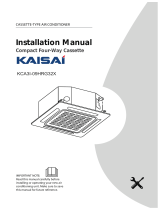
CLEANING AND MAINTENANCE WARNINGS
CAUTION
•
Turn o the air conditioner and disconnect the power if you are not going to use it for a long time.
•
Turn o and unplug the unit during storms.
•
Make sure that water condensation can drain unhindered from the unit.
•Do not
operate the air conditioner with wet hands. This may cause electric shock.
•Do not
use device for any other purpose than its intended use.
•Do not
climb onto or place objects on top of the outdoor unit.
•Do not
allow the air conditioner to operate for long periods of time with doors or windows open,
or if the humidity is very high.
ELECTRICAL WARNINGS
•
Only use the specified power cord. If the power cord is damaged, it must be replaced by the
manufacturer
, its service agent or similarly qualied persons in order to avoid a hazard.
•
Keep power plug clean. Remove any dust or grime that accumulates on or around the plug. Dirty
plugs can cause re or electric shock.
•
•
•
•
•
•
•
Do not
pull power cord to unplug unit. Hold the plug firmly and pull it from the outlet. Pulling
directly on the cord can damage it, which can lead to fire or electric shock.
Do not
modify the length of the power supply cord or use an extension cord to power the unit.
Do not
share the electrical outlet with other appliances. Improper or insucient power supply
can cause re or electrical shock.
If connecting power to xed wiring, an all-pole disconnection device which has at least 3mm
clearances in all poles, and have a leakage current that may exceed 10mA, the residual current
device(RCD) having a rated residual operating current not exceeding 30mA, and disconnection
must be incorporated in the xed wiring in accordance with the wiring rules.
For all electrical work, follow all local and national wiring standards, regulations, and the
Installation Manual. Connect cables tightly, and clamp them securely to prevent external forces
from damaging the terminal. Improper electrical connections can overheat and cause re, and may
also cause shock.
All electrical connections must be made according to the Electrical Connection
Diagram located on the panels of the indoor and outdoor units.
All wiring must be properly arranged to ensure that the control board cover can close properly. If
the control board cover is not closed properly, it can lead to corrosion and cause the connection
points on the terminal to heat up, catch re, or cause electrical shock.
The product must be properly grounded at the time of installation, or electrical shock may occur.
TAKE NOTE OF FUSE SPECIFICATIONS
The air conditioner’s circuit board (PCB) is designed with a fuse to provide overcurrent protection.
The specifications of the fuse are printed on the circuit board ,such as :
T5A/250VAC, T10A/250VAC, etc.
T20A/250VAC(<=24000Btu/h units)T30A/250VAC(>24000Btu/h units)
NOTE: For the units with R-32 refrigerant , only the blast-proof ceramic fuse can be used.
Safety
Precautions
Page 5
•Do not
clean the air conditioner with combustible cleaning agents. Combustible cleaning agents
can cause re or deformation.
•
Turn o the device and disconnect the power before cleaning. Failure to do so can cause
electrical shock.
•Do not
clean the air conditioner with excessive amounts of water.





















